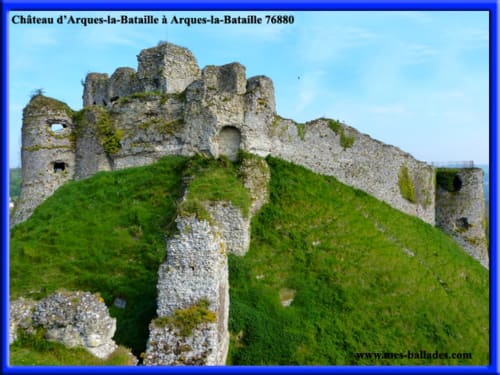
Originally, the seigneury of Saint-Aubin-le-Cauf (Sanctus Albinus) was a strong fief of Haubert, ie whose owner was obliged to be armed knight and held to serve the king. St Aubin was then part of the vast feudal domain of the dukes of Normandy. In the 11th century (around 1031), Robert the Magnificent Duke of Normandy was lord country lord and owned all the lands from Dieppe to Douvrend, through Arques and all the forest of the Aliermont. Witness of this time, the fortress of the castle of Arques built in the year one thousand is one of oldest of France.
The village was then peopled with 200 families, about 1000 souls and had a tower (at a place called Noville) St Louis yielded to Eudes Rigaud (Archbishop of Rouen from 1248 to 1275) in July 1262. At the end of the 12th century Richard Coeur-de-Lion ceded the village to the archbishop of Rouen, who possessed it until the Revolution.

By 1568, Protestants held public meetings in St Aubin. They opened a sermon in 1571 on the domain of the lord whose title of stronghold assured them all security. This region of Normandy was valiantly defended by Henry IV himself during his wars against the league to conquer his kingdom before abjuring.

Saint Aubin le Cauf was the home of fields of Claude Groulard, Marquis de Torcy, first president of the Parliament of Normandy and founder of the hospices of Rouen. He bought this land from Louis de Montberon and owned a mansion where he loved to spend his holidays. In 1592, Henri IV, winner and wounded of the battle of Aumale:
"Battle of Aumale: Henry IV against the Duke of Parma [receives a blow in the kidneys, enters the manor of Claude Groulard by the small bridge in stone and brick to stay a few days to recover from his injury (only injury serious of all his life - Battle of Aumale: Henry IV against the Duke of Parma receives a blow in the kidneys -sce wikipedia »

As a sign of recognition (around 1603), the King of France erects the seigniory of St Aubin chatellenie in favor of Claude Groulard, with "right four-pillar forks", ie the right to justice and hanging on the pillars (to gibbet).
It is in the old ogive vaulted stables, supported by elegant pillars, that the sepulchral statues of Claude Groulard and his second wife, Barbe Giffart, were protected from the revolutionaries. These tombs remained hidden until 1841 when the historian of the Parliament of Normandy, Mr Floquet, discovered them. Later, Marguerite de Choiseul, wife in first wedding of Louis du Moucel direct descendant of Claude Groulard and last lord of St Aubin, then owner of the castle of St Aubin granted the statues to the department. They both rest in the chapel Saint-Etienne in the cathedral of Rouen.

On the site of the feudal foundations, the descendants of Claude Groulard, have built in the 18th century a modern castle in pink brick and stone roofed Mansart. Marguerite de Choiseul married in 2nd marriage the Duke of Fitz-James in 1825 and became Duchess of Fitz-James. She lives in the Château de la Rivière-Bourdet. She died in 1862 with no direct heir, the castle and lands of St Aubin are then auctioned in Paris and Dieppe. The estate will remain the property of the Groulard family for 250 years.
Subsequently, the castle changed owners several times. In 1926, Mr. Dupuis owner and farmer farmer, had the Gothic architecture stables with crosses of warheads to the historical monuments. The foundations of the castle, the bridge witnessing the passage of Henri IV which spans the ancient moat, the bread oven and the stables are the architectural witnesses of the 13th and 16th centuries.

In the 1930s, this summer castle was purchased by Grace Wishar, widow of a British tea farmer in Ceylon, who in 1934 married Alexander Alekhine (1892-1946). The castle of St Aubin will be the last residence of this illustrious world champion of chess Franco-Russian remained undefeated.
During the war, the castle will be occupied by a regiment of the German army which makes its headquarters there and transforms it into a hospital. From this time remains the guardhouse, small brick house built by the German army at the entrance of the estate.
At the death of Alekhine in 1946, his wife, yielded to the family of current owners who discovered vandalized, emptied of any furniture and looted any reusable material.
Since then, the owners are working to renovate and make this architectural ensemble live.